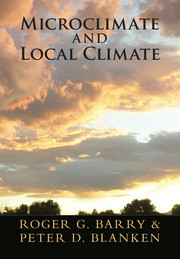Preface
Published online by Cambridge University Press: 05 May 2016
Summary
This book aims to provide a concise overview of microclimates and local climates – climatic conditions on scales of centimeters to meters and 10 m to 1 km, respectively. There has been no recent treatment of this topic. It has been a decade or more since these topics have been addressed in a textbook, and there have been numerous advances in methodology and understanding over that interval. New instrumentation and increased resolution of satellite and airborne remote sensing have greatly expanded the possibilities for observations and have been accompanied by improved models and data assimilation techniques.
The text is aimed at upper level undergraduates and beginning graduate students in environmental sciences, physical geography, climatology, and biological sciences. The topic of small-scale climate is one that is of interest not only to climatologists but also to biologists, crop scientists, and specialists in landscape design. There are texts that approach the subject from an agricultural perspective using a theoretical framework, and there are texts that either are outdated or have regional coverage. Our book fulfills the need for an up-to-date text that bridges both theory and practice, and encompasses a global geographic perspective. Its scope covers the physical principles that determine micro- and topoclimate.
The text begins with definitions of microclimate and local climate (or topoclimate), a brief history of the two areas, and a case study. Chapter 2 describes each of the microclimatic elements in turn (temperature, moisture, and wind) including carbon dioxide, photosynthesis and respiration, the nitrogen cycle, and pollutants. Chapter 3 summarizes methods of observation and instrumentation. Chapter 4 treats solar, infrared, and net radiation. Chapter 5 describes the energy balance components – soil heat flux, momentum and mass exchange, sensible and latent heat fluxes, and advective effects. Chapter 6 addresses the monitoring and modeling of radiation and energy balance via remote sensing and land surface models. Chapter 7 deals with the microclimates of different vegetated environments – arctic and alpine tundra, grassland, farmland, wetlands, and coniferous, deciduous, and tropical forests. Chapter 8 similarly treats the microclimates of physical systems – lakes, rivers, snow cover, mountains, and cities. Chapter 9 examines human and animal bioclimatology. Part II opens with a discussion of urban climates in Chapter 10. Chapter 11 then analyzes topoclimatic effects on microclimates. Part III examines environmental change; Chapter 12 looks at the effects of climate change on microclimates.
- Type
- Chapter
- Information
- Microclimate and Local Climate , pp. ix - xPublisher: Cambridge University PressPrint publication year: 2016



